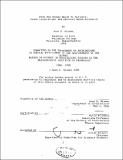From the Cheney House to Taliesin : Frank Lloyd Wright and Feminist Mamah Borthwick
Author(s)
Nissen, Anne D. (Anne Dorrit)
DownloadFull printable version (14.78Mb)
Alternative title
Frank Lloyd Wright and feminist Mamah Borthwick
Other Contributors
Massachusetts Institute of Technology. Dept. of Architecture.
Advisor
David Friedman.
Terms of use
Metadata
Show full item recordAbstract
This thesis seeks to investigate the impact of Frank Lloyd Wright 's contact with feminist theory on his design and his thinking. For, in 1912, Wright and his companion Mamah Borthwick co-translated a book by Swedish feminist Ellen Key into English. I argue that Key's notion of an "organic" system of male-female relationships prompted Wright to redefine his notion of what an organic architecture should be; and, that this shift in understanding led to the birth of Wright's first "natural house," Taliesin, which was built for Wright and Borthwick's life together. Ellen Key believed that the values which she associated with women's childrearing responsibilities -- those of love and empathy -- should be honored above all other societal values. These values were to flow out of the house into the public realm, so that in a world transformed by Key's "sex morality," men would share them, and restructure their actions accordingly. Taliesin 's location in rural Wisconsin made it possible for Wright and Borthwick to construct a private life based on respect for the natural forces of sexuality and nature. Therefore Wright could say that "the house married the hill" on which Taliesin sat. Moreover, I believe that Taliesin's design is governed by Key's empathetic approach -- that of listening rather than imposing. Taliesin is not a hierarchical composition of traditional domestic signs; instead, the relationship of space within the house to space outside it is as important, if not more so, than the actual physical fabric in which Wright rendered his individual design statement.
Description
Thesis (M.S.)--Massachusetts Institute of Technology, Dept. of Architecture, 1988. Bibliography: leaves 168-169.
Date issued
1988Department
Massachusetts Institute of Technology. Department of ArchitecturePublisher
Massachusetts Institute of Technology
Keywords
Architecture.